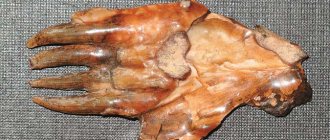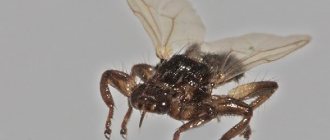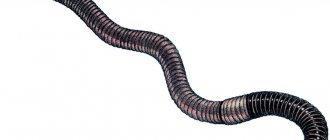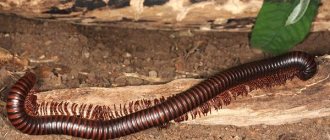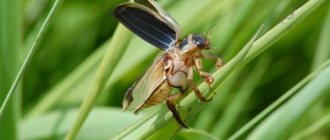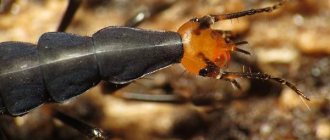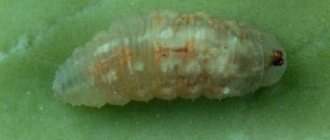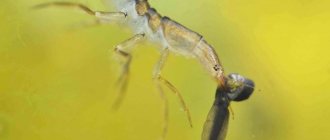Description
Few people have heard of sand fleas.
We all sincerely believe that such parasites, swarming in the sand and biting people, are found somewhere abroad, in southern countries. And here we are not mistaken - in the middle latitudes you can rarely find an unpleasant resident in the sand near a lake, but in the south they are often found. Since people began to travel around the world and prefer to vacation somewhere on the shores of the Andmaman Sea to the Black Sea, the risk of meeting a sand flea is growing every year. So residents of middle latitudes are not immune from the bite of the parasite. These are the so-called sand fleas, or amphipods. They belong to the Talitridae family. These fleas are otherwise called beach fleas. Local residents have known about them for a long time, tourists only recently learned about them.
They are very small in size. Their length is only 1-2 mm, but they can jump up to 40 mm. Fleas are dark brown in color and look like shrimp - their body consists of separate segments. They are believed to belong to the same family as cat fleas. Insects do not have wings, but they have long legs.
Few people have heard of sand fleas.
Insect activity occurs in the evening and morning hours - at dawn or sunset. It is at this time that they bite more often.
Scallop
This is another family of mollusks, of which there are more than 250 species in the World Ocean. Several species of such animals live in the Black Sea. They have round doors that look like a fan.
When danger appears, scallops can jump sharply and move along the seabed; rapana is not scary for them. The meat of this mollusk is considered a delicacy, and the shells are often used to make souvenirs for tourists.
The scallop has very tender, sweetish meat; it can be used to prepare various seafood dishes, or can be eaten raw. There are especially many French national dishes with scallops.
Interesting facts about sea fleas
- In total, more than two thousand species of fleas have been described.
- Entomologist Charles Rothschild collected a collection of fleas. It is kept in a museum in Britain.
- When a flea hatches from an egg, it immediately begins to look for a host to live on. Usually this is one of the mammals.
- Fleas have the ability to transmit infectious diseases from one to another.
- Gammarus goes through 4 stages in life: egg, larva, pupa, and adult.
- Flea saliva contains substances that can cause severe allergic reactions.
- The eggs mature in about 7 days.
- The lifestyle of Gammarus is semi-terrestrial. They spend time in the area near the shore and in the deep sea. At the same time, they always try to get out onto land.
- Wash your feet after walking on the beach.
Sea bass
These Black Sea marine inhabitants are similar in appearance to river perches, but have so many other differences from each other that they belong to completely different orders of fish. In addition, sea bass is one of the dangerous fish in the Black Sea.
It has sharp fins equipped with poisonous glands. One prick from such a fin causes a rather unpleasant sensation in a person, especially a child, although it is not long-lasting and does not cause significant harm to health.
Sea bass, as a rule, lives on the bottom near the coastal zone, in algae. Leads a sedentary lifestyle. Some individuals can live up to several decades. Sea bass is a predator, feeding on small fish and crustaceans.
Why are they dangerous?
Both males and females bite humans. Males drink blood, leaving behind only the bite site and itching. A female's bite is fraught with more than just irritation. Females use humans as a source of blood necessary for reproduction.
The sea sand flea burrows into the skin and attaches itself to a blood vessel, feeding on the blood it needs to mature its eggs. At the same time, it increases and reaches the size of a pea. As soon as the eggs are ripe, she shoots them out of the wound and dies.
The remains of the female remain in the microscopic wound, which causes suppuration and severe pain. The disease caused by sand fleas in this way is called sarcopsillosis, or tungiasis.
Both males and females bite humans
Habitat, appearance, lifestyle and method of reproduction
The process of reproduction of the penetrating flea
The parasite was initially described in Brazil almost immediately after Columbus's voyage.
Interesting!
The first bites were recorded on Christopher Columbus's caravel "Santa Maria".
According to the place of the first description, the insect was called Brazilian. With ships, the parasite gradually spread throughout all tropical countries and today is found in Africa, India, and Thailand. Sand fleas are common in Vietnam. These insects today can be found wherever there are suitable climatic conditions for them.
Appearance
A very small parasite, whose closest European relatives are rat fleas. Unlike “native” ectoparasites, the sand flea has very long hind legs and a short body. Below is a comparison photo of a cat flea (left) and a piercing Brazilian flea (right).
Benefits from insects
We are familiar with fleas as parasites that cause great trouble for both animals and people. But the sea flea brings quite a lot of benefits to the ecology of beaches. As you know, a large number of microorganisms live on the beach and in coastal waters, some of which are very dangerous to humans. The sea flea in this case is simply irreplaceable and brings great benefits, since it cleanses beach areas of harmful microorganisms. They are natural orderlies who clean and prevent the growth of dangerous microorganisms.
Benefits for the ecology of the beach
Environmental scientists have proven that fleas naturally clean coastal sand by feeding on microorganisms living in it. However, they, of course, are unable to process pieces of cigarette butts, chips, meat - everything that careless vacationers leave behind in the city beach area.
Crawling out of their hiding places in the evening, crustaceans also clean coastal waters. Small sacs in the area of the front legs allow them to breathe oxygen.
Do not panic and deprive yourself of a sea holiday, thinking about bites and their consequences. Gammarus, the photo of which you see in the article, is not so scary. If you follow the basic rules of caution, it will not interfere with any rest.
- Modern scientists have described 2086 species of fleas.
- The British Museum houses a collection of these creatures, which was collected by Charles Rothschild, a banker and entomologist.
- A flea hatching from a pupa immediately looks for a host animal to settle on. As a rule, this is a representative of mammals.
- The flea is capable of transmitting infectious diseases from one host to another.
- The paws of sea fleas are of different sizes and serve for different actions. Some help you swim, others help you run.
- Gammarus has four life stages: egg, larva, pupa, and adult.
- The components of sea flea saliva can cause allergic reactions.
- The maturation period for egg laying is about 7 days.
- Gammarus lead a semi-terrestrial lifestyle, spending time in the coastal zone of beaches and in the deep sea, but always strive to get out onto land.
If it were not for the existence of crustaceans, our beaches would be mired in the remains of dead snails, mollusks and jellyfish.
Most often in the summer, people want to take a vacation, go as far as possible from the bustle of the city, to the sea. Warm waves, soft sand, ripe fruits, hot sun - these are the best things that can restore the body after the monotonous life of a metropolis.
Few people know what kinds of fauna lie in wait for numerous tourists on the flowing sand of the coast.
Sea fleas are one of the representatives of resort areas that can cause significant discomfort to vacationers. These small crustacean creatures are capable of biting a person so much that he will wonder whether he should go to the sea next time, or whether it is better to spend his holiday at a ski resort.
Danger to humans
Despite the enormous benefits for the environment, these parasites, like other fleas, can attack humans in order to satisfy hunger. They do not disdain human blood and therefore often attack vacationers. Both female and male individuals can attack, but the bites differ from each other.
For example, when a male bites, it requires a small amount of blood to saturate, the bite occurs quickly, it is comparable to a mosquito. After a bite, the area is swollen and accompanied by itching. In the case of a female bite, it is compared to a tick attack.
The female needs much more time to saturate; just like a tick, she strongly attaches to the blood vessel and penetrates under the skin. The female needs food to reproduce. In addition, the symptoms are also different; the affected area in the female specimen swells greatly; in the center you can see a black dot, which is the parasite itself. A white abscess also appears and the affected area begins to hurt.
The female continues to suck blood until her offspring mature, and as she satiates, she increases significantly in size. When the eggs mature, she shoots them out over fairly large distances. After the eggs are laid, the female dies without leaving the human body. This leads to serious consequences, since insect remains provoke inflammation and suppuration, which in turn leads to the development of tungiasis and sarcopsillosis. Medical care and proper treatment are necessary, without which gangrene and blood poisoning may develop, which, as is known, lead to the death of a person. Most often, fleas attack the areas of the feet, legs, buttocks and groin.
Who are they
Few can distinguish an ordinary flea, which feeds mainly on the blood of warm-blooded animals, from other crustaceans that are similar in appearance and structure. Therefore, the question often arises - who are sea fleas?
The sea flea in the Black Sea, also called gammarus, is a crab-like creature that can bring severe pain to humans during bites.
It is because of these creatures that most tourists who come to relax on the sea coast remain dissatisfied with their vacation, and many even decide not to return to the resort area.
For vacationers, finding themselves in a situation where their legs are simply covered with bloodsuckers becomes simply catastrophic.
Daphnia (water fleas), unlike sea fleas:
- feed exclusively on plankton, waste organic matter, bacteria, and unicellular algae;
- at the same time, they pass water currents through themselves. They do not feed on human blood, and are the so-called “cleaners” of the water depths;
- their body is covered with a leathery bivalve shell ending in two hooks of the original horny appearance;
- Having one eye, consisting of many small eyes, daphnia are very well oriented in water, since the visual organ is highly mobile;
- Water fleas spend most of their lives in the aquatic environment, rarely moving onto land.
The habitat of daphnia is puddles, ponds, reservoirs, small lakes, etc. They inhabit several continents at once.
The exception is equatorial territories. The largest populations are seen in subtropical climates.
Recently, water fleas can be seen in the sea, in vast areas that are unusual for their usual habitat. This is due to human activity and the exploration of new territories of the globe.
Actions when bitten
If you find a sea flea bite, remember not to scratch the skin, as this leads to infection. You should take some steps and use products that will improve the condition of the affected skin area and relieve symptoms.
These include:
- Shower. The very first thing to do is take a shower. But it is very important to shower without a bathing suit. The fact is that there may be larvae on it, which already at this stage of development need nutrition and cause painful bites. After the attack of the larvae, a rash and irritation appear. It is also necessary to wash your swimsuit/swimming trunks and towels. Before washing, they are wiped with alcohol or vinegar, and then washed using detergent.
- Vinegar, alcohol. These remedies help get rid of unbearable itching. To do this, you need to soak cotton wool in vinegar and apply it to the affected area, then let the product dry on the skin. You can also dilute alcohol with water and apply it to the bite, in this case it helps get rid of toxins.
- Cold compress. You can use ice, which is wrapped in a cloth or towel and applied to the sore spot. Allows you to relieve swelling and get rid of severe pain.
- Calamine lotion. This remedy perfectly relieves itching. This drug is not recommended for use in children under 6 months of age, as well as in pregnant women and during breastfeeding. Hydrocortisone ointment has a similar effect, but for children under 10 years of age it can only be used after consultation with a doctor.
- Soda. This remedy will help get rid of itching and relieve inflammation. You can use soda as a compress; for this, take 3 tablespoons of soda and dilute with 1 spoon of water. A thick paste is applied to the affected area for half an hour. You can also take a bath with baking soda; for this you need to use 1 glass of powder per bath of water. You need to stay in such a bath for at least half an hour. Instead of baking soda, you can add 2 cups of oatmeal to the bath, which has a similar effect. Remember that the water should not be hot, as this can make the situation worse.
- Aloe vera. Preparations with aloe vera have an excellent effect on the skin, relieve inflammation, and reduce irritation.
- Essential oils. Cedarwood, lavender, and tea tree oils are used, which relieve irritation well.
- Anti-inflammatory, non-steroidal drugs. They help relieve pain and inflammation, these include aspirin, ibuprofen and others.
If you detect a bite from a female, be sure to consult a doctor, since it is necessary to remove the parasite in order to prevent complications. In addition, when the symptoms do not go away, and the site of the lesion is disturbing, medical attention will also be required, since this indicates an infection or a possible allergy to the saliva of the parasite, which requires treatment.
Unfortunately, there are cases where, after a bite from this small parasite, sepsis developed, which led to amputation of the fingers. An attack by these fleas cannot be ignored as the consequences can be quite serious and life-threatening. Sometimes symptoms manifest themselves as headaches, nausea, weakness, fever, which in turn, without proper treatment, leads to serious consequences.
Sea snakes
It's serious
: Snakes living in water produce more toxic venom than their terrestrial counterparts.
The good news is that when bitten, very little venom is released to seriously harm a person. Only 2 species of sea snakes are deadly. But a meeting with the safest of them cannot be called pleasant - the bite will hurt, tumors, swelling, allergies, and weakness are possible. In water, animals do not attack and try to hide as quickly as possible. But if a snake has washed up on land, you definitely shouldn’t touch it.
Where do they meet?
: warm seas of the Pacific and Indian oceans, most of all in the South China Sea.
Security measures
: Do not touch sea snakes. They are shy and will not attack themselves. If you manage to get a snake bite, there is no need to wipe it with vinegar. And don’t even think about “treating yourself” with alcohol – it promotes vasodilation and rapid absorption of poison. You can try to suck out the poison with a blood-sucking jar, syringe or mouth (but only if there are no wounds in the mouth).
Treatment of sea flea bites
To alleviate the condition after a sea flea bite, you can use the following remedies:
- Do not scratch the bite site, as this can lead to skin infection.
- Take a shower. After discovering that you have been stung by sea fleas, you must first remove your swimsuit. Then take a shower. Some people make the mistake of showering in their bathing suit. The larvae still remain on it and continue to sting the person. To prevent rashes, the swimsuit is wiped with alcohol or vinegar, then washed with detergent and dried.
- Using vinegar and alcohol. These products are often used to relieve sea itch. It is necessary to moisten a cotton ball in vinegar and apply it to the sore spot. Do not wash off; skin must air dry. Taking a vinegar bath will also help. Alcohol diluted with water will help neutralize toxins.
- Using cold compresses. Several ice cubes are wrapped in a towel and applied to the affected areas. This procedure is performed until the symptoms subside. It is also possible to wet a washcloth in cold water and apply it to sore spots.
- Apply calamine lotion. It will help reduce itching sensations. A small amount of lotion is applied to the affected area with gentle movements. It is necessary to consult a doctor before applying this lotion if it is planned to be used during pregnancy or breastfeeding, as well as for children under six months. It is also possible to use hydrocortisone ointment to relieve itching. It is used with caution in children under 10 years of age.
- Taking a bath. To relieve redness and reduce itching, you can take a bath with baking soda. To do this, pour one glass of soda into a bath of warm water and spend in it from half an hour to one hour. You can mix 3 parts baking soda with one part water and stir them to form a thick paste. It is applied to the affected area and left on it for 30 minutes. Then the soda is washed off. It is also possible to take an oatmeal bath. Oatmeal contains antioxidants that will soothe your skin. To prepare such a bath, you will need to pour two glasses of oatmeal into a bath of warm water. In order not to aggravate the situation, you should not make the water in the bath hot.
- Application of preparations with aloe vera. Aloe is used to treat many skin diseases. It will soften the skin and reduce irritation and itching.
- Use of essential oil. Oils such as tea tree, cedar oil, and lavender oil will relieve irritation. The oil is applied directly to the skin. To prevent irritation from the oil, it is mixed with a carrier oil.
- Use of non-steroidal and anti-inflammatory drugs. For example, ibuprofen, aspirin. They will relieve inflammation and discomfort.
It is necessary to seek medical help if the bite site looks like a small mound with a dark center. The doctor must remove the parasite that has penetrated the skin. You should also consult a doctor if your condition worsens after applying calamine lotion or hydrocortisone ointment. Perhaps there is an infection in the wound or there is an allergy to the flea saliva. Your doctor may prescribe an antihistamine ointment. She will calm down the irritation.
How to tell if your guinea pig has fleas
Like all skin parasites, fleas feed on the blood of animals. In order to get it, they pierce the animal’s skin and suck blood. Immediately after the puncture, the insects release saliva into the wound, which has an irritating effect, so it will not be difficult to find out that the pig has been infected by fleas. This will become noticeable through changes in her behavior.
Appearance of parasites
If you suspect that your pig has fleas, you need to examine its fur. You should use a comb to push the hairs apart in several places and inspect the skin. Fleas will be visible. These are small insects with an elongated brown body, flattened laterally. There are spines on their belly and paws that help the parasites cling to the skin and fur. They move by jumping.
In addition to ectoparasites, upon examination, nits and discharge can be detected on the animal’s skin. The nits are small and light in color. Located on hairs. They are very difficult to remove because they are firmly attached. You can tell that you have flea discharge in front of you by dropping a drop of alcohol on a dark spot. The excrement turns red.
Symptoms
You can determine that there are skin pests on your pet’s body by how it behaves. The pig will be constantly irritated and aggressive. Since flea bites are accompanied by itching and pain, the animal often itches and can scratch the skin until it bleeds.
The presence of fleas is indicated by the following signs:
- abrasions;
- wounds;
- bald spots;
- dermatitis;
- scabs;
- unhealthy, matted, dull coat appearance.
It will be noticeable from the pig's behavior that it is trying to get rid of someone. If the problem is not addressed in time, the animal will develop other health problems - anemia, eczema, purulent wounds, allergies.
Possible consequences of a bite
If you do not take any measures after being bitten by crustacean parasites and constantly scratch the bite site, the consequences can become very unpleasant. There are cases when, after being bitten by a sea flea, the victim developed sepsis and his toes were amputated. It is important to know that you should not settle on the sea next to sand where there are algae. Algae are the favorite habitat of sea fleas.
In addition to itching and discomfort after a sea flea bite, the following symptoms may be present in particularly severe cases: fever, chills, nausea, headaches, red eyes.
Symptoms
The bite from an adult thimble jellyfish is usually painful, and you will not immediately notice the attack of their larvae. Only after some time will you feel a tingling sensation in areas of the body covered or subject to friction from swimming or diving equipment. For example, the armpits, groin, chest, inner thighs, neck.
Find out more Do cat fleas bite people?
A rash will then appear within 24 hours. Sea flea rash is usually very itchy and accompanied by raised, red patches of skin with bumps or blisters of varying sizes. They can in some cases form a dense mass on the skin, similar to sand flea bites.
In addition to itching and blisters, the rash may be accompanied by the following symptoms, especially in more severe cases:
- Fever;
- Chills;
- Nausea;
- Headache;
- Fatigue, especially in children;
- Urethritis (inflammation of the urethra);
- Redness of the eyes.
Symptoms vary from one person to another depending on the body's response to the sting. People who develop the rash earlier are more likely to develop symptoms.
“People with allergic reactions who are immunocompromised are at higher risk of developing severe rashes,” says Mebane, MD, medical director of the Divers Alert Network (DAN). Sea flea rashes last from a couple of days to a week. In severe cases, it may take several weeks to heal completely.
How to prevent parasite bites
Unfortunately, it is impossible to completely exclude the possibility that you will be bitten by a sea flea, but it is quite possible to reduce the chances to a minimum.
To do this you need:
- Remember that insects are most active in the morning and when the sun sets, so at this time walks on the beach should be carried out only in shoes, do not sit down or lie down on the sand with your naked body.
- Avoid areas on the beach where there are algae, such areas are the habitat of parasites and there they are most concentrated.
- When you sunbathe you need to use a sun lounger.
- On the beach, wear only beach shoes.
- Use special insect repellent sprays.
- Visit only beaches that are intended for vacationers.
- Check your body regularly.
Other possible names for the Brazilian flea
The scientific name of the parasite is Tunga penetrans. Perhaps this flea lived in other tropical areas on the American continents, but it was first described in Brazil. Hence the first name – “Brazilian earthen”. The second name is a direct translation of Latin and means “penetrating flea.” Reflects the conditions under which the female lays eggs.
In English, in addition to Sand flea, there is a second name for this dangerous parasite - jigger. In each language this insect is called differently, so it is usually enough for a tourist to know the English name of the flea. And remember that "Sand flea" can cause confusion, while jigger indicates a specific type of insect.
Important!
Do not confuse the colloquial name of the parasite jigger (jigger) with chigger (chigger) - a parasitic mite.
How to get rid of a rash quickly - effective remedies
Although sea flea bites are harmless and heal within a week in most cases, the rash and itching are very uncomfortable.
The home remedies for sea rash listed below will help relieve you from the discomfort of itching and other symptoms, speeding up the healing process.
Do not rub or scratch the skin
This is not the way to get rid of a rash, no doubt. Scratching or rubbing the affected area will only make the condition worse.
The urge to scratch itchy areas can be overwhelming, but restrain yourself from doing so. If you use a towel to dry yourself after a shower, gently pat your skin rather than rubbing it across the surface.
Take a shower
Doctors recommend removing your swimsuit or wetsuit as soon as you realize you have been stung by sea lice before showering with fresh water and soap.
Taking a shower will help relieve skin irritation. One mistake people often make is washing while still wearing a soiled swimsuit. This causes the larvae to become trapped in the fabric of your suit and sting.
To prevent recurrence of the rash and other symptoms, wipe down swimming or diving suits with vinegar or rubbing alcohol, then wash them with detergent, then dry them. Air drying is often not sufficient to kill digitalis jellyfish larvae and other parasites. In cases of severe rash, it is best to change your swimsuit.
Apply oatmeal
Oatmeal has soothing properties, making it one of the most effective home remedies for water flea rash.
Getting rid of rashes with oatmeal is quite simple:
- In a small bowl, combine 2 tablespoons oatmeal with ¼ cup water.
- Heat the mixture for 5-10 minutes to soften the oats.
- Gently apply the prepared oatmeal to the affected areas of the skin.
- Repeat this home treatment several times a day to speed up healing.
Bathing with a colloidal oatmeal product such as Aveeno Soothing Bath is also beneficial.
Rub in calamine lotion
Calamine lotion helps stop itching and reduce rashes. Available without a prescription at most pharmacies, Calamine Lotion is especially recommended for children, according to the Department of Health.
Use vinegar or wipe with alcohol
Vinegar and rubbing alcohol have long been used to relieve sea rashes. This not only helps kill the maggots that cling to the skin, but also soothes the itching.
- For vinegar, apply a cotton ball that has been soaked in diluted white vinegar to the stung areas of the skin. Do not rinse; Allow the leather to air dry.
- Bathing in a vinegar bath also helps.
- As for rubbing alcohol, it helps neutralize toxins remaining on the skin. Apply it diluted with a cotton ball.
Use the porridge
According to Sarah Buchanan, a writer for the Daily Star, applying cooked porridge to affected areas of the skin helps soothe it and relieve rashes and itching.
Take antihistamines
Antihistamines help get rid of the rash. They block the action of histamine and stop the urge to scratch the affected area. Among the most common antihistamines are:
- diphenhydramine;
- chlorpheniramine;
- loratadine (Claritin).
However, antihistamines should not be used in children without a doctor's approval.
Hydrocortisone cream
Application of 1% hydrocortisone cream on the affected areas of the skin, 2-3 times a day, 1 - 2 weeks, helps get rid of the rash. This reduces itching and the discomfort associated with it.
However, hydrocortisone creams should not be used on the vaginal or rectal areas for children under 12 years of age. Should not be used at all on children under 2 years of age.
Ice packs, cold compresses
Ice helps relieve pain associated with sea rash.
- Wrap a few ice cubes in a clean towel, then apply it to the problem areas. Repeat the procedure regularly until the rash and other symptoms disappear.
- You can also soak a washcloth in cold water and squeeze out the excess water. Then, apply it to the affected area several times a day to relieve symptoms.
Apply special gel
There is a product called Tender Jellyfish Sting Relief Gel. With ammonia as the active ingredient, this product is designed to relieve the pain and itching associated with sea flea rashes.
According to the manufacturer, this sting gel is suitable for treating irritation caused by poisonous plants such as poison ivy.
Take your medicine
Non-steroidal anti-inflammatory drugs (NSAIDs). For example, ibuprofen and aspirin are useful for relieving inflammation (swelling) and discomfort.
Aspirin should not be given to children under 16 years of age to avoid putting them at risk of a rare condition known as Rice syndrome.
You should consult a dermatologist if none of the methods help relieve symptoms. You may be developing a secondary bacterial infection or a very severe allergy.
Treatment for head lice may include the use of prescription corticosteroid creams along with other medications such as antihistamines, NSAIDs such as ibuprofen, and others.
Pharmaceutical preparations to relieve itching and swelling
Among the wide variety of pharmaceutical ointments that eliminate itching and swelling after insect bites, you can choose a drug for both adults and children. Before applying the product, you should carefully study the manufacturer's recommendations. Ignoring them may make the problem worse. The table provides a description of some of the most effective antipruritic and decongestant drugs in ointment or gel form:
| Drug name | Active substance | Contraindications | Minimum age at which the use of ointment (gel) is permitted, months | Features of application | |
| Are common | Private | ||||
| Advantan | Methylprednisolone aceponate | Hypersensitivity to the components of the drug | Tuberculous, viral or syphilitic processes, rosacea, perioral dermatitis in the area of application | 4 | Apply once a day in a thin layer. You cannot apply it daily for 3 months in a row for adults and 1 month for children. |
| Fenistil-gel | Dimetindene maleate | Angle-closure glaucoma, prostatic hyperplasia | 1 | Apply 2–4 times daily. In case of severe itching, treat the affected area, then take the drug in the form of drops. | |
| Levomekol | Chloramphenicol, methyluracil | Not found | 12 | Cover the wound with a sterile gauze pad soaked in the product. | |
| Hydrocortisone ointment | Hydrocortisone | Rosacea, skin rashes, acne, open wounds, neoplasms, tuberculous, viral or syphilitic processes in the area of application | 24 | Apply ointment 2–4 times a day for 6–14 days. | |
| Sulfuric ointment | Sulfur | Not specified | Apply ointment 2-3 times a day. | ||
Homemade products according to folk recipes
If these blood-sucking insects have bitten you at home, it is possible to cope with the consequences of their bites with the help of folk remedies. Their only drawback is the need for self-preparation, which is why most people prefer to use pharmaceutical preparations. To treat itching and swelling, medicinal plants and ingredients that can be found in any kitchen are commonly used. Information on how to prepare the most effective folk remedies and how to treat them correctly is presented in the table:
| Ingredients | Preparation | Application |
| Soda | 1 tsp. Dissolve a spoonful of soda in 200 ml of warm water. | Apply a piece of gauze soaked in the solution to the itchy skin. The procedure time is 10–15 minutes. You can apply the compress 2-3 times a day until the itching and swelling disappear. |
| Sagebrush | Prepare a highly concentrated wormwood decoction. | Wipe the bitten area several times a day with a cotton pad moistened with a decoction. |
| Aloe | Wash the fleshy leaf of the plant thoroughly. Lightly mash it and cut lengthwise. | Apply the plant to itchy and swollen skin for 10–15 minutes, securing it with a bandage or adhesive tape. This procedure can be carried out several times a day. |
| Plantain | Rinse the plant well under running water and mash to release the juice. | |
| Dandelion | ||
| Citric acid, vinegar | Mix 0.5 tsp. citric acid, 100 ml vinegar and 200 ml cool water. | Treat the affected area several times a day with a cotton pad moistened with medicinal liquid. |
| Lemon | Squeeze the juice out of the fruit. | |
| Garlic | Chop a few cloves of garlic. | Make a compress by applying the paste to the sore spot and securing it with a bandage. After 2 hours, remove the garlic mass and wash the wound. If during the procedure the bitten person experiences a strong burning sensation, remove the paste and rinse the skin with cold water. |
What is sea lice rash on humans?
The term "sea flea rash" is a misnomer because sea lice (ectoparasites of marine fish that do not harm humans) are not the actual cause of the itchy rash. It is also referred to as sea itch, pika-pika, sea poisoning, sea rash, Caribbean rash.
These rashes appear when a swimmer, scuba diver or snorkeler comes into contact with and is stung by tiny larvae of foxglove jellyfish (Linuche unguiculata), sea anemone (Edwardsiella lineata) and other species of marine life.
These miniature sea creatures have several specialized stinging cells on their bodies called nematocysts.
When touched, the tentacles with natatocysts of jellyfish and sea anemones inject toxins in self-defense. Toxins are responsible for the rash.
Of all the sea larvae that can cause sea lice rashes, the most common culprits are foxglove jellyfish larvae. This means that when people complain about sea flea bites, they should really be talking about thimble jellyfish bites.
In water, foxglove jellyfish larvae cannot be seen with the naked eye. They often sneak through swimsuits and diving suits, where they become trapped. When they are near the body, they begin to sting, for the purpose of self-defense.
Although they occur at any time of the year, sea flea stings and the associated itchy rash occur between April and August.
Florida, the Gulf of Mexico, and the Caribbean are the most dangerous areas where lesions are common, and similar problems have been reported in South America (Brazil), Australia, Southeast Asia (Thailand, Philippines) and New Zealand.
In Mexico, people visiting Cancun, Cozumel and other popular tourist destinations during the warmer months are at particular risk of developing sea flea rash. I can personally attest to this after my bad experience in Cancun.
Cases of sea fleas have been reported to be increasing in recent years. This has prompted authorities in several parts of the US (especially Florida), the Caribbean and Mexico to place purple flags along contaminated sea beaches as a warning sign during the peak season.
Treatment for flea bites
Treatment of flea bites is aimed at alleviating the condition of the victim. To relieve itching and swelling, you need to anoint the affected skin with antipruritic and decongestant ointment. For this purpose, you can use ready-made or self-prepared products. If an allergy-prone person who has been attacked by fleas does not show signs of an allergic reaction, he should in any case be given an antihistamine. Suprastin, Zodak, Claritin and other similar products will help prevent the development of allergies and prevent the worsening of its symptoms.
Insects with which the sand flea can be confused
It's good to know the enemy by sight. It’s even better to distinguish between its other varieties. In Thailand, other insects can be mistaken for sand fleas. True, their bites are not so dangerous.
- Mosquitoes and midges. Their bites are very similar to flea bites, but are essentially harmless.
- Ants. They can take revenge on a person if he accidentally crushes them with his hand or body. They usually crawl on people by accident. An ant bite leaves a lump that may hurt for some time.
- Bedbugs. They are extremely rare. Mostly in bungalows and not very well maintained hotels. After bedbugs, a “path” of bites remains, but the affected areas never swell.
How are bites treated in Thailand and Vietnam?
Insect bites at resorts are treated with local antihistamines. However, in difficult cases, this approach can be called rather preventive: if the parasite has penetrated the skin, then it is impossible to do without the intervention of a specialist. Local doctors constantly encounter such problems and know exactly how and with what to treat the consequences of the activities of beach insects.
Popular remedies for bites in Thailand and Vietnam:
- Yellow Balm;
- Compound Dexamethasone.

